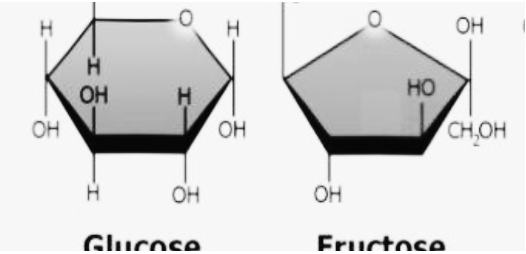Fructose
Fructose is a ketonic monosaccharide. Monosaccharides are the basic units of carbohydrates that cannot be broken down further. They are classified by the carbohydrate’s functional group.
An aldose contains an aldehyde group, while a ketose contains a ketonic group. Also known as fruit sugar. Fructose, glucose, and galactose are all monosaccharides found in human diet.
Fructose discovery
Fruit sugar was discovered by Augustin-Pierre Debrunfaut. Most root vegetables and vine and tree fruits contain it. It typically disaccharides with sucrose. This sugar is made from corn, sugar cane, and sugar beets. Excessive consumption can lead to obesity and insulin resistance.
Chemical Formula: C6H12O6
Physical and Chemical Properties of Fructose
- Carbohydrates can be fermented anaerobically by yeast or bacteria into carbon dioxide and ethanol.
- Fruit sugar is employed in Maillard Reaction with amino acids over glucose because the reaction proceeds quickly.
- They dehydrate quickly to hydroxymethylfurfural. (‘HMF’).
- It’s a crystalline white solid.
- Compared to other sugars, these carbs are very soluble.
- Compared to other sugars, they absorb moisture quickly and release it slowly.
Fructose Structure
- Fructose is cyclic.
- The keto group results in the intramolecular hemiacetal.
- Here, C5-OH joins the second position ketonic group.
- Chiral carbon and two CH2OH and OH group configurations result.
Thus, D-fructose exhibits stereoisomerism in which α-D-fructopyranose and β-D-fructopyranose are the isomers.

Uses of Fructose
- Crystalline fructose is utilized to enhance food flavour.
- Infused water, energy drinks and low-calorie items contain it.
- Fruit sugar is utilised in soft moist cookies, nutrition bars, and other low-calorie items.
Glucose
Sugar having six carbon atoms and one aldehyde group, glucose is a simple sugar with no further chemical constituents. Monosaccharide with the chemical formula C6H12O6 is what we’re talking about.
It is also referred to as dextrose. It is referred to as aldohexose due to the fact that it has 6 carbon atoms and an aldehyde group in its structure. It can be opened in two different ways: as an open-chain structure or as a ring structure. Animals’ livers and kidneys are responsible for its production. It can be found in plants in a variety of forms, including fruits and other portions of the plant. D-glucose is the type of glucose that occurs naturally in the body. In either solid or liquid form, it is possible to come upon this substance.
Properties of Glucose
C6H12O6 | Glucose |
Molecular Weight/ Molar Mass | 180.16 g/mol |
Density | 1.54 g/cm³ |
Melting Point | 146 °C |
Simple sugar | Monosaccharide |
Sugar can be referred to either aldohexose or dextrose, depending on the context. It is a monomer of many bigger compounds, such as carbohydrates, starch, and cellulose, and it has a crystalline structure. This is the organic substance that is found in the greatest quantity on the planet. It was determined that the structure depicted above was appropriate based on the evidence presented below:
- Its molecular formula is C6H12O6, which stands for carbon, hydrogen, and oxygen.
- When HI is heated over an extended period of time, the compound n-hexane is created, indicating that all six carbon atoms are bonded together in a straight chain.
- The oxime is created when glucose combines with hydroxylamine and cyanohydrins when hydrogen cyanide is added to it, resulting in the formation of oxime. The existence of the carbonyl group in glucose can be confirmed using this reaction.
- In the presence of a mild oxidising agent such as bromine water, glucose is oxidised to carboxylic acid, which has six carbon atoms, and this is known as carboxylation. In this case, the carbonyl group is present in the form of a carboxylic acid group.
- The existence of the -OH group is confirmed by the acetylation of glucose with acetic acid, which results in the formation of glucose pentaacetate.
- When glucose and gluconic acid are both oxidised with nitric acid, dicarboxylic acid and saccharic acid are produced. This indicates the existence of primary alcohol in the system.
Structure

Uses Of Glucose
- It is used to treat hypoglycemia (low blood sugar) (low blood sugar)
- It is given to people who are really ill and unable to eat since it contains carbohydrates and calories.
- It is employed in the treatment of elevated potassium levels in the bloodstream (hyperkalemia)
- It is utilised as a precursor in the synthesis of a variety of compounds.
Conclusion
Fructose, popularly known as fruit sugar, is the only ketohexose that occurs naturally in the body. It is also referred to as levulose because it possesses a significant levorotatory optical rotation, which makes it a good candidate for this designation.
Glucose is the monosaccharide with the greatest abundance. Glucose is also the aldohexose that is most commonly found in the bodies of most living species. The fact that glucose has a lower potential than other aldohexoses to react nonspecifically with the amine groups of proteins could be one explanation for this. Glycation is a chemical reaction that weakens or destroys the activity of numerous proteins, as shown, for example, in glycated haemoglobin.
 Profile
Profile Settings
Settings Refer your friends
Refer your friends Sign out
Sign out




